Recognizing the significance of cat anxiety is paramount in ensuring the well-being of our beloved feline companions.
With experts shedding light on effective strategies to assist cats in coping with anxiety, cat owners are presented with valuable tools to support their pets through challenging times.
By delving into the nuanced world of cat anxiety management, a deeper understanding of feline behavior and emotions can be gained.
Stay tuned to discover practical insights and actionable steps that can make a tangible difference in your cat's life.
Key Takeaways
- Cat anxiety is triggered by various factors like genetics, trauma, and changes in routine.
- Understanding a cat's unique language and habits is essential in managing their anxiety.
- Consult a vet for a thorough assessment and consider behavior modification strategies.
- Consistency, patience, and trial-and-error are vital in helping cats cope with anxiety.
Understanding Cat Anxiety Triggers
The identification of cat anxiety triggers is essential in comprehending the underlying factors that contribute to feline distress and unease. Various stimuli can lead to anxiety in cats, such as changes in routine, travel, new people, loud noises, and health issues.
It is crucial to recognize that genetics, trauma, and lack of socialization can also play a significant role in triggering anxiety in our feline companions. Additionally, certain cat breeds may be more susceptible to attachment-related anxiety, making it important to understand individual predispositions.
Signs and Symptoms of Anxiety
Common indicators of cat anxiety encompass a range of behavioral and physical manifestations that can serve as cues to the emotional distress experienced by feline companions. Some signs and symptoms of anxiety in cats include:
- Hiding and avoiding interaction
- Trembling or shaking
- Defensive behaviors like hissing or swatting
- Elevated blood pressure and gastrointestinal issues
Recognizing these signs early can help address your cat's anxiety and prevent it from escalating into more severe health issues. By observing your cat's behavior closely and seeking professional guidance, you can better support your furry friend's emotional well-being.
Impact of Anxiety on Cat Health
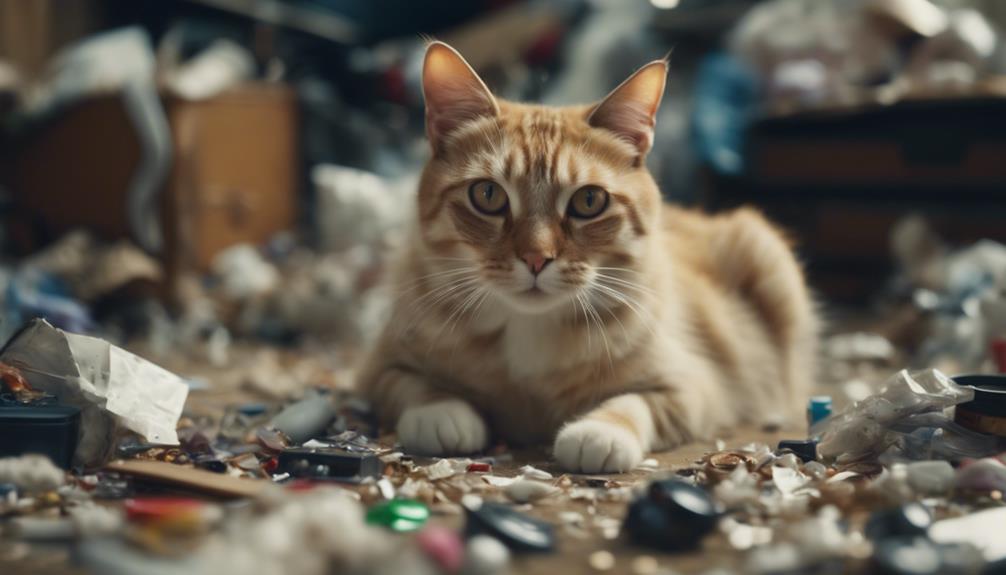
Understanding the ramifications of anxiety on cat health is paramount for ensuring the overall well-being of our feline companions. Anxiety can have a significant impact on a cat's physical and mental health. Chronic anxiety in cats may lead to elevated stress levels, which can manifest in various ways such as increased blood pressure, gastrointestinal issues, and a weakened immune system. Persistent anxiety can also contribute to the development of other medical conditions as it puts a strain on the cat's overall health.
It is crucial to address anxiety in cats promptly to prevent further health complications and provide them with the care and support they need to thrive. By recognizing and addressing anxiety-related issues, we can help our cats lead happier and healthier lives.
Decoding Cat Behavior
Deciphering the intricacies of cat behavior requires keen observation and an understanding of their unique communication cues. Cats communicate through a combination of body language, vocalizations, and actions, which can offer valuable insights into their emotional state and needs.
Here are some key points to consider when decoding your cat's behavior:
- Tail position and movement convey different messages.
- Purring is not always a sign of contentment.
- Slow blinking is a sign of trust and affection.
- Vocalizations vary in tone and intensity based on emotions.
Differentiating Emotions in Cats
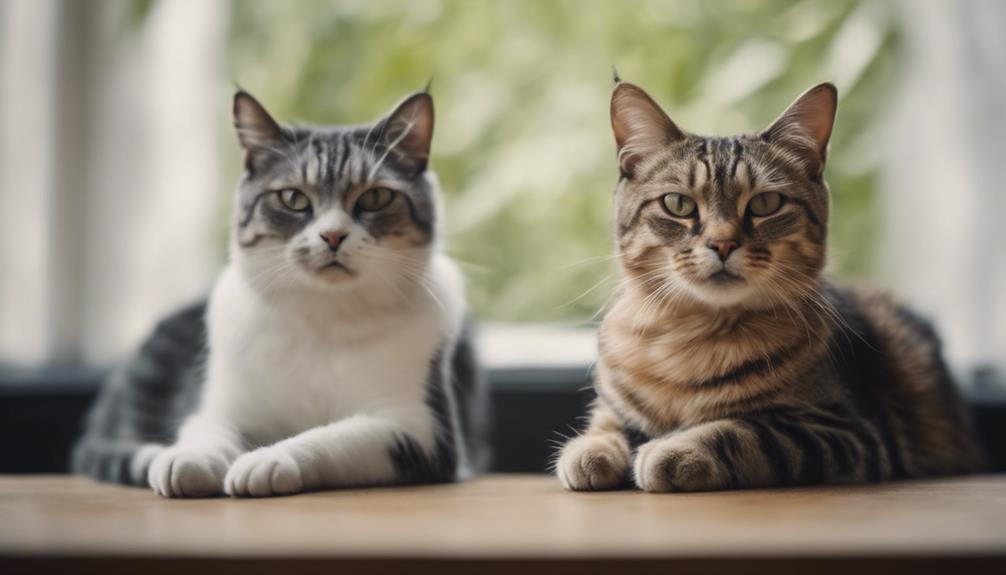
Within the realm of feline behavior, discerning the nuanced spectrum of emotions exhibited by cats requires astute observation and interpretation of their subtle cues. Cats communicate their feelings through body language, vocalizations, and behavior patterns.
Understanding a cat's emotions involves recognizing signs of contentment, fear, stress, and affection. Tail position, ear movements, eye dilation, and vocal signals all play a role in deciphering a cat's emotional state. For instance, a cat with flattened ears and dilated pupils may be experiencing fear or anxiety, while a purring cat with relaxed body language is likely content.
Veterinary Assessment for Anxiety
Differentiating emotions in cats requires a keen understanding of feline behavior. When addressing anxiety, a crucial step is obtaining a comprehensive veterinary assessment.
- Veterinary Assessment Steps:
- Physical examination to rule out medical issues.
- Behavior history evaluation to understand triggers.
- Observation of behavior during the visit.
- Discussion of treatment options and next steps.
A thorough veterinary assessment is essential in uncovering the underlying causes of anxiety in cats. With the expertise of a veterinarian, tailored interventions can be implemented to support your kitty's emotional well-being effectively.
Behavior Modification Strategies
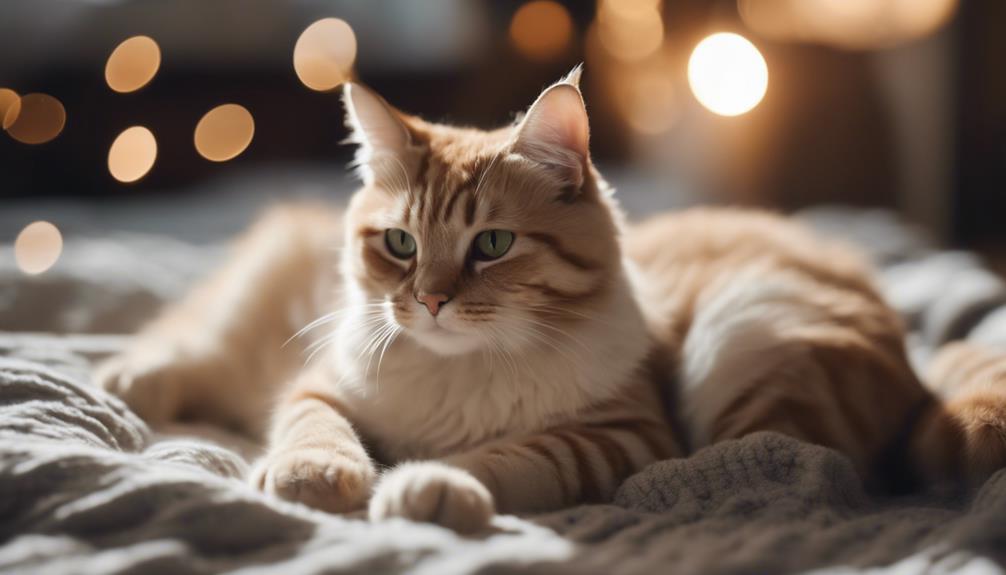
An essential aspect in addressing cat anxiety involves implementing tailored behavior modification strategies to alleviate their distress and improve their overall well-being. By working closely with a veterinarian and behavior consultant, a personalized plan can be developed to help your furry companion cope better with their anxiety triggers. Below is a table outlining some effective behavior modification strategies that can be incorporated into your cat's routine:
| Behavior Modification Strategies | Description |
|---|---|
| Environmental Enrichment | Enhancing your cat's living space with toys, scratching posts, and perches to promote mental stimulation and physical activity. |
| Positive Reinforcement Training | Rewarding desired behaviors with treats or affection to encourage positive responses and reduce anxiety triggers. |
| Desensitization Techniques | Gradually exposing your cat to anxiety-inducing stimuli in a controlled manner to help them become more comfortable over time. |
| Establishing Routine | Creating a predictable daily schedule for feeding, playtime, and rest to provide stability and reduce uncertainty for your cat. |
Implementing Exposure Therapy
To address cat anxiety effectively, implementing exposure therapy is a strategic approach. This method involves gradually introducing anxiety-inducing stimuli in a controlled manner to help cats become more comfortable and confident over time. Exposure therapy can be instrumental in helping your feline friend overcome their fears and anxieties.
Here are some key points to consider:
- Start Slow: Introduce anxiety triggers gradually.
- Create a Safe Environment: Ensure the cat has a safe space to retreat to.
- Use Positive Reinforcement: Reward calm behavior during exposure.
- Seek Professional Guidance: Consult a veterinarian or animal behaviorist for expert advice.
Medication and Supplements for Anxiety
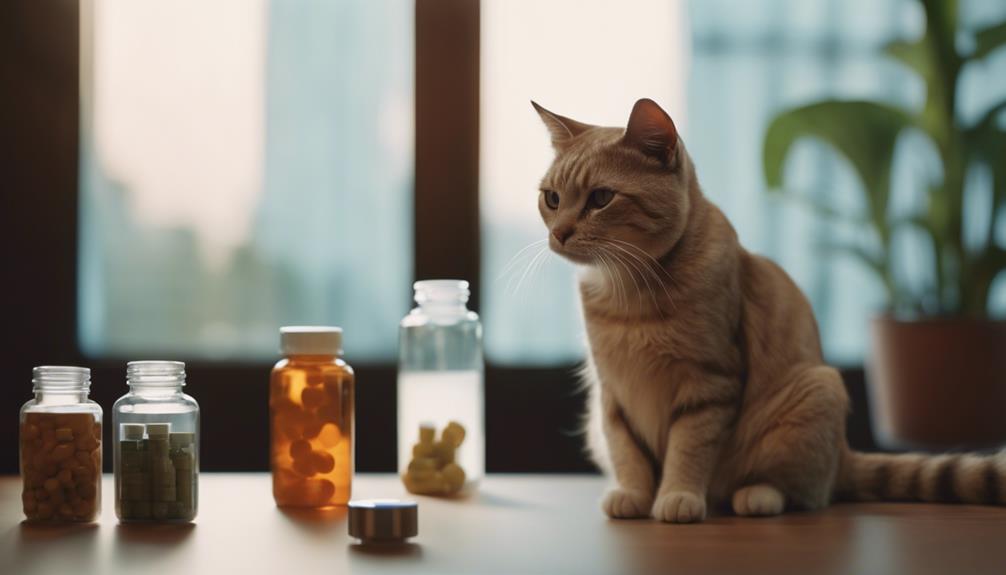
When addressing cat anxiety, considering the potential role of medication and supplements is a crucial aspect of comprehensive treatment planning. In severe cases where behavior modification alone may not suffice, medication such as Prozac (fluoxetine) or supplements like calming pheromones can be prescribed by a veterinarian. These medications can help alleviate the symptoms of anxiety in cats and aid in their overall well-being.
It is important to work closely with a vet to determine the most suitable medication or supplement for your cat's specific needs. While medication and supplements can be beneficial, they should always be used in conjunction with other treatment approaches to ensure a holistic and effective management of your cat's anxiety.
Consistent Management Approaches
Implementing a consistent approach to managing cat anxiety is essential for achieving positive outcomes in your feline companion's well-being. Consistency provides stability and predictability, which are crucial for reducing your cat's anxiety levels.
Here are some key strategies to help you establish a consistent management approach:
- Establish Routine: Stick to a consistent daily routine to create a sense of security for your cat.
- Provide Safe Spaces: Ensure your cat has access to quiet, safe spaces where they can retreat when feeling anxious.
- Use Positive Reinforcement: Reward calm behavior to reinforce positive associations and reduce anxiety triggers.
- Maintain Environmental Enrichment: Stimulate your cat's mind with toys, scratching posts, and interactive play to alleviate stress and anxiety.
Coping Tips for Anxious Cats
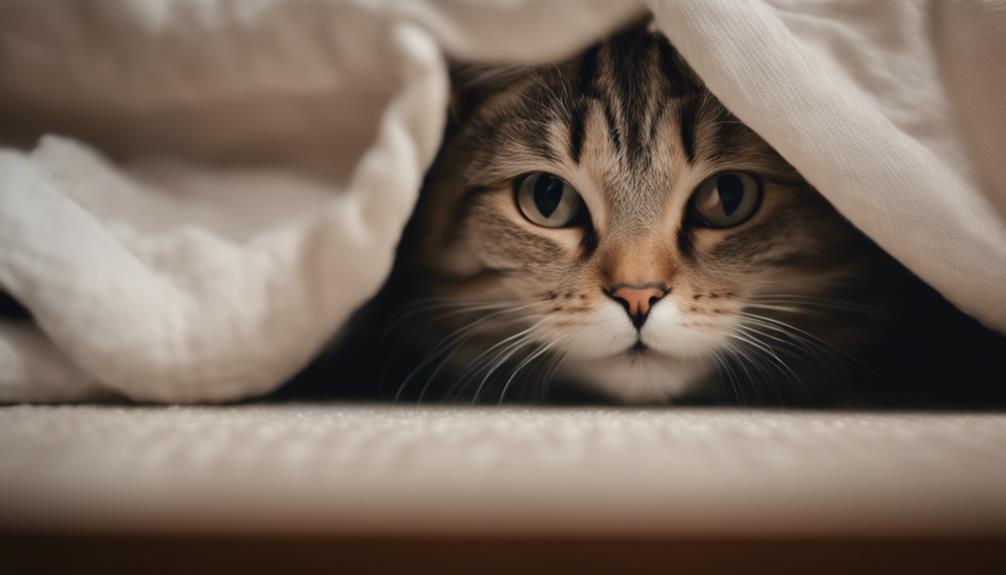
In managing cat anxiety, providing structured routines and safe spaces is crucial for helping anxious felines cope effectively. Cats thrive on predictability, so establishing a consistent daily schedule can help reduce their stress levels.
Ensure that your cat has a designated area where they feel secure, such as a cozy hiding spot or a perch with a view. Implementing interactive toys, puzzle feeders, and calming pheromone diffusers can also aid in keeping your cat mentally and physically engaged.
Additionally, creating a peaceful environment by minimizing loud noises and sudden changes can contribute to a sense of security for your anxious cat. By prioritizing their comfort and well-being, you can support your feline companion in managing their anxiety effectively.
Professional Help for Cat Anxiety
Seeking professional guidance is essential for effectively addressing and managing cat anxiety in a structured and comprehensive manner. When it comes to helping your anxious feline friend, here are some key points to consider:
- Veterinary Consultation: A thorough assessment and tailored treatment plan are crucial.
- Behavior Modification: Work with a vet and behavior consultant to develop effective strategies.
- Exposure Therapy: Gradual exposure to triggers can help your cat overcome anxiety.
- Medication Support: In severe cases, medication like Prozac or supplements may be necessary.
These steps, when implemented diligently and with care, can significantly improve your cat's well-being and quality of life.
Related Articles for Further Reading

For those seeking additional information on managing cat anxiety, exploring related articles can provide valuable insights and guidance.
Articles such as 'Signs of stress in dogs,' 'Guide for flying with cats,' and 'Identifying anxiety in dogs' can offer further knowledge on related topics that may indirectly impact a cat's anxiety levels.
Understanding stress indicators in dogs can help cat owners identify similar signs in their feline companions. Additionally, learning how to fly with cats can be beneficial for reducing travel-related anxiety in cats.
Exploring resources on identifying anxiety in dogs may also provide a broader perspective on recognizing and addressing anxiety in pets. These related articles can complement your understanding of cat anxiety and enhance your ability to support your furry friend.
Terms of Service Review
Exploring the guidelines and regulations outlined in the Terms of Service is essential for cat owners seeking to navigate their responsibilities and rights within the context of managing cat anxiety effectively. It is vital to understand the terms that govern the services you are utilizing to ensure a smooth experience for both you and your feline companion.
Here are some key points to consider:
- Understanding your obligations as a user.
- Knowing the rights you have as a customer.
- Familiarizing yourself with any potential limitations or restrictions.
- Being aware of the consequences of non-compliance.
Newsletter Subscription Option
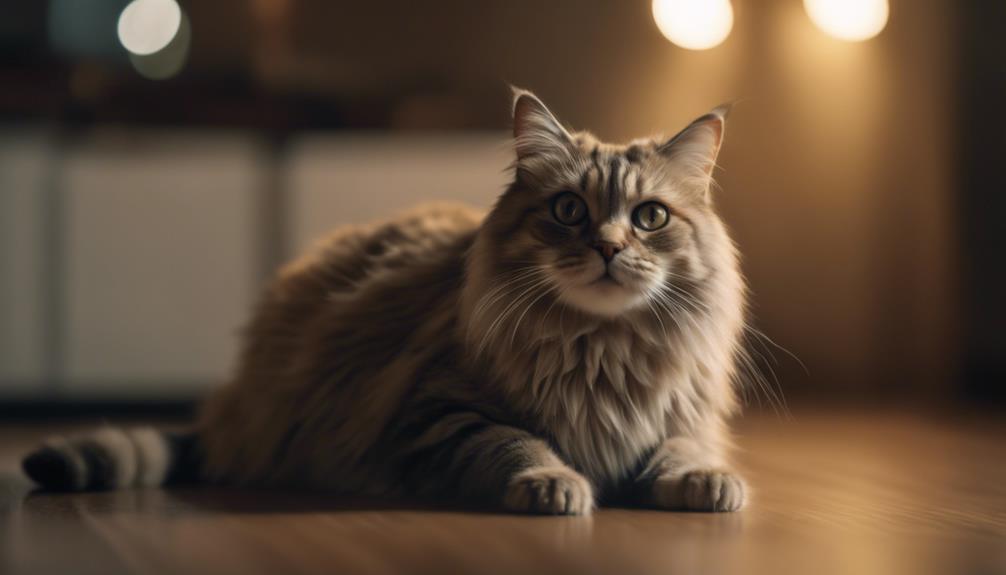
Upon registering on our platform, users can opt-in to receive our informative newsletter, enhancing their knowledge of cat anxiety management techniques. Our newsletter provides exclusive insights from experts in the field, offering practical tips and strategies to help your kitty cope with anxiety.
Subscribers will receive regular updates on the latest research, product recommendations, and real-life stories of successful anxiety management. By subscribing, you become part of a supportive community dedicated to improving the well-being of our feline friends.
Stay informed, stay connected, and join us in creating a happier and healthier environment for your beloved cat. Don't miss out on this valuable resource – sign up for our newsletter today!
Frequently Asked Questions
Can Cats Develop Anxiety Disorders Similar to Humans?
Cats can develop anxiety disorders akin to humans due to various triggers like changes in routine, genetics, or health issues. Consult a vet for evaluation and treatment, which may involve behavior modification, exposure therapy, or medication for severe cases.
How Can Music or Pheromone Therapy Help Alleviate Cat Anxiety?
Music and pheromone therapy can help alleviate cat anxiety by creating a calming environment. Music with soothing melodies can reduce stress, while pheromone diffusers release calming scents. Consult a veterinarian to determine the best approach for your cat.
Are There Specific Breeds of Cats That Are More Prone to Anxiety?
Specific cat breeds, like Siamese, Burmese, and Abyssinian, may be more predisposed to attachment-related anxiety. However, individual temperament plays a significant role. Consulting with a veterinarian can provide tailored guidance on managing anxiety in these breeds.
Can Changes in Diet or Nutrition Help Manage Cat Anxiety?
Changes in diet or nutrition may complement behavior modification for cat anxiety. Consult a veterinarian to discuss potential dietary adjustments or supplements that could support your cat's emotional well-being. Every cat is unique, so a tailored approach is essential.
Is There a Link Between a Cat's Environment and Their Anxiety Levels?
The environment plays a critical role in a cat's anxiety levels. Factors like changes in routine, new people, loud noises, and lack of socialization can trigger anxiety. Understanding and modifying the environment can significantly impact a cat's well-being.
Conclusion
In conclusion, addressing cat anxiety is crucial for promoting the well-being of our feline companions.
By understanding anxiety triggers, recognizing signs and symptoms, and seeking professional help when needed, cat owners can support their cats in coping with anxiety.
It is important to decode cat behavior, differentiate emotions, and stay informed to effectively manage and alleviate their distress.
With knowledge and compassion, cat owners can create a safe and secure environment for their anxious feline friends.




